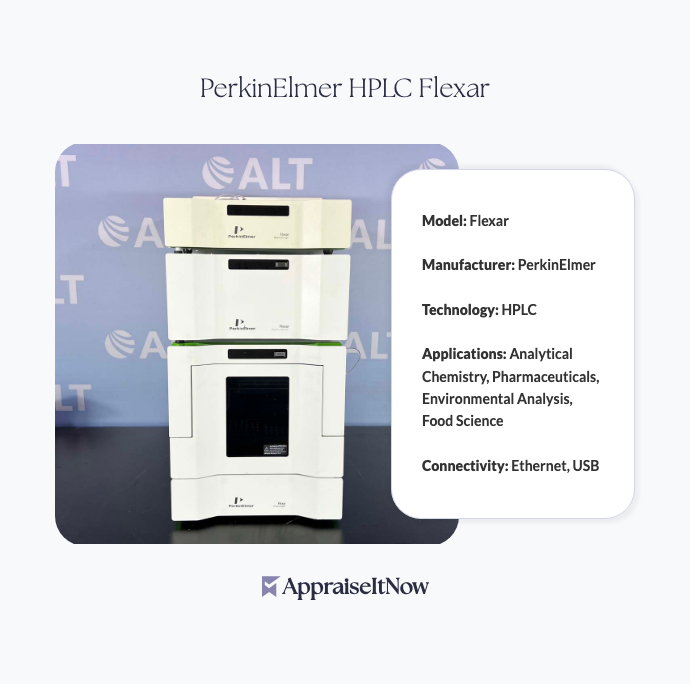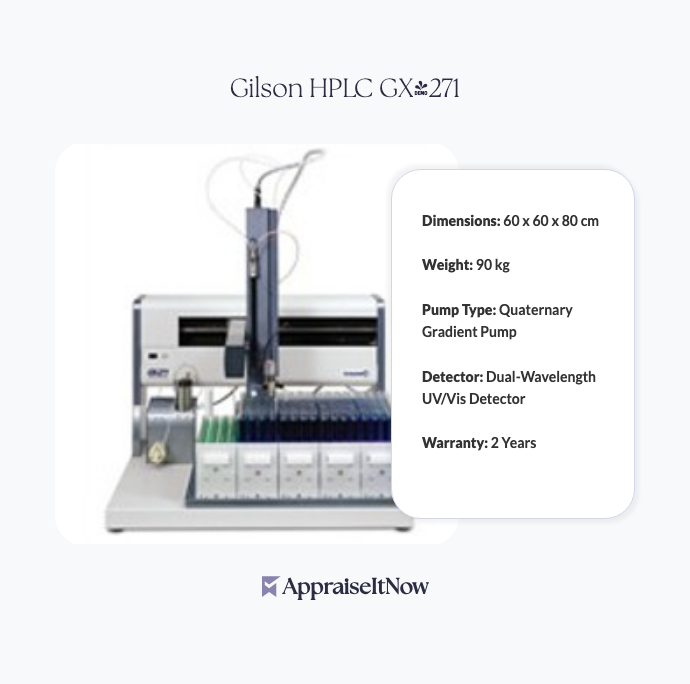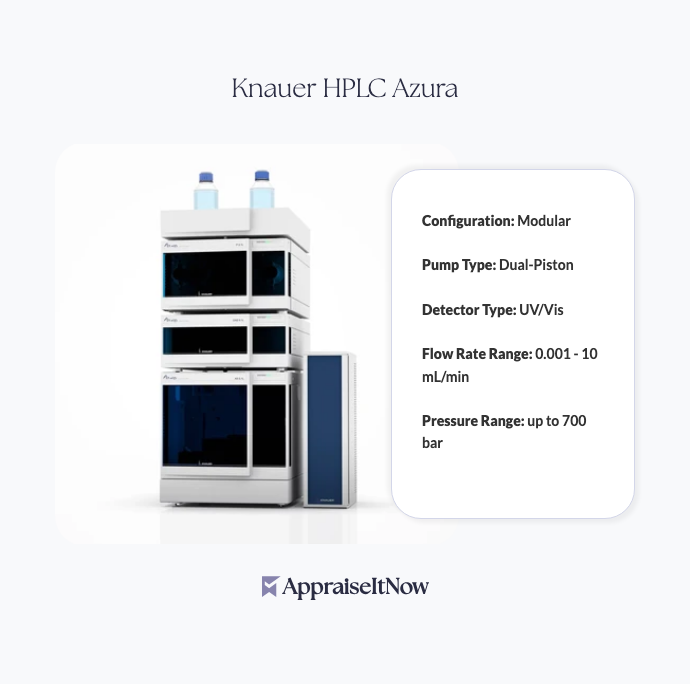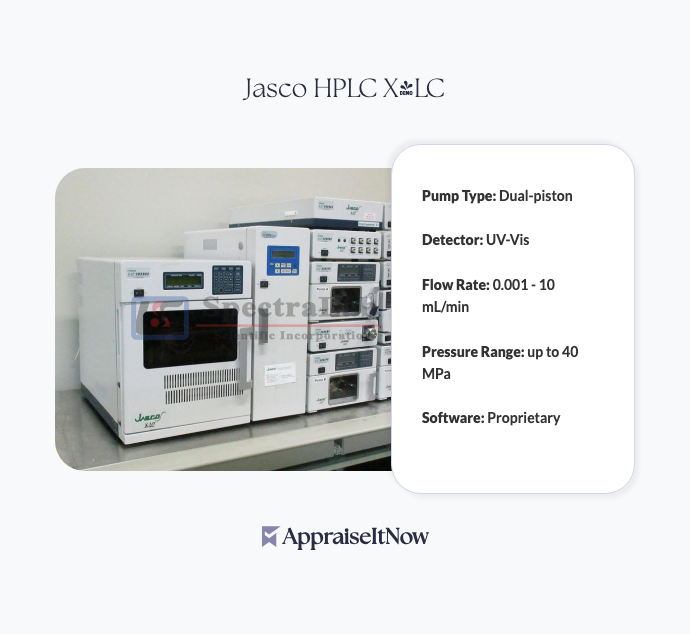<h1>How to Get Your PerkinElmer HPLC Flexar Appraised</h1>
<p>The PerkinElmer HPLC Flexar is a sophisticated analytical instrument that has become indispensable in pharmaceutical laboratories, environmental analysis, and food science applications. Whether you're evaluating your system for insurance purposes, preparing for a sale, or documenting its value for tax considerations, understanding how to obtain an accurate appraisal is essential. Current market estimates place a used PerkinElmer Flexar in the <strong>$50,000 to $75,000</strong> range, though this can vary significantly based on configuration, condition, and service history.</p>
<h2>Understanding PerkinElmer Flexar Market Value</h2>
<p>Your PerkinElmer HPLC Flexar represents a substantial laboratory asset that has retained considerable value since its introduction in 2010. This high-performance system combines advanced optics, precise temperature control, and cutting-edge software capabilities that continue to meet industry demands. The modular design allows customization for specific analytical applications, which influences both its initial cost and resale value. Understanding what drives market pricing helps you establish realistic expectations when seeking professional valuation.</p>
<p>Several factors directly impact your Flexar system's current worth. A newer model with minimal hours of operation and comprehensive service records commands premium pricing within the $50,000 to $75,000 range. Conversely, older units with higher usage history or limited documentation may appraise toward the lower end. The presence of original accessories, validated software licenses, and installation documentation substantially affects valuation.</p>
<div class="callout tip"><p><strong>Appraiser's Insight</strong></p>
<p>Systems with documented preventive maintenance schedules and recent calibration records typically appraise 15-20% higher than comparable units lacking such documentation.</p></div>
<h2>Key Factors Affecting Your Flexar's Appraisal Value</h2>
<p>When appraisers evaluate a PerkinElmer HPLC Flexar, they examine multiple interconnected variables that collectively determine fair market value. Your system's year of manufacture, current firmware versions, and available spare parts inventory significantly influence pricing. A 2015-model Flexar with recent software updates and a complete set of original columns and detectors will appraise substantially higher than a 2010 model with aging components.</p>
<p>The specific detector configuration matters considerably—systems equipped with PDA (photodiode array) or MS (mass spectrometry) detection capabilities command higher valuations than UV-only variants. Likewise, the condition of critical components such as the pump, injector, and column oven directly correlates with appraisal value. Appraisers verify that all major systems function within manufacturer specifications through detailed performance assessment protocols.</p>
<p>Your Flexar's integration history affects its desirability. Systems that have been successfully interfaced with data management software like Chromeleon or integrated into validated analytical workflows appeal to established laboratories. Documentation demonstrating successful method development, regulatory compliance (especially for pharmaceutical use), and troubleshooting records enhance perceived value and justify premium pricing.</p>
<h2>Documentation and Service Records You'll Need</h2>
<p>Preparing for a professional appraisal requires gathering specific documentation that appraisers use to verify your system's history and condition. The most critical documents include your original purchase receipts, installation certificates, and all service and maintenance records spanning the system's operating life. These records demonstrate that your Flexar has been properly maintained according to manufacturer specifications, directly translating to higher appraisal values.</p>
<p>Calibration and validation documentation proves particularly important for pharmaceutical or regulated laboratory environments. If your system has undergone IQ/OQ (Installation Qualification/Operational Qualification) or analytical method validation, maintain these records meticulously. They substantiate your Flexar's compliance with industry standards and regulatory requirements like USP or EPA protocols. Similarly, any HPLC column inventory lists, detector specifications, and software licensing agreements should be compiled and made available to your appraiser.</p>
<p>Photographic documentation of your system's current physical condition—including images of the entire apparatus, close-ups of major components, and any visible wear or modifications—helps appraisers assess condition without requiring extensive travel. Digital records of error logs, service alerts, and performance trending data (if your system stores this information) provide valuable insights into operational reliability and history.</p>
<div class="callout note"><p><strong>Documentation Benefit</strong></p>
<p>Clear, comprehensive records can increase your appraisal value by reducing uncertainty and demonstrating professional stewardship of laboratory equipment.</p></div>
<h2>How Appraisers Verify Performance and Calibration</h2>
<p>Professional appraisers employ specific methodologies to confirm that your PerkinElmer Flexar performs within manufacturer specifications. This verification process typically begins with a comprehensive physical inspection examining the pump for leaks, checking detector responsiveness, and assessing the condition of internal optics. Appraisers look for signs of corrosion, component deterioration, or modifications that might indicate extensive use or environmental challenges.</p>
<p>Performance verification often includes running diagnostic tests using reference standards to confirm baseline system suitability. This approach parallels methodologies used when appraising other <a href="/types/lab-equipment">lab equipment</a> and <a href="/types/chemical-equipment">chemical equipment</a> where functional capacity directly impacts value. Your appraiser may conduct wavelength accuracy checks, detector sensitivity tests, and injection reproducibility measurements using standard protocols established within the analytical chemistry community.</p>
<p>Calibration status verification involves checking whether your system has current calibration certifications and whether it meets accepted tolerance standards. Many laboratories maintain calibration records that appraisers review to understand maintenance patterns and any instances of out-of-specification performance. Systems that have never required major repairs and maintain consistent calibration intervals appraise significantly higher than those with erratic service histories.</p>
<h2>Appraisal Methods for Laboratory Equipment</h2>
<p>Determining fair market value for your PerkinElmer Flexar involves applying one or more of three primary appraisal methodologies, each offering distinct perspectives on what your system is worth in today's market. The <strong>market approach</strong> compares your Flexar to recently sold comparable systems, examining sale prices of similar models with comparable configurations and operating hours. This method works particularly well for specialized instruments like HPLC systems where documented transactions within the past 12-24 months provide reliable pricing benchmarks.</p>
<p>The <strong>cost approach</strong> estimates value by calculating replacement cost minus accumulated depreciation based on age, condition, and functional obsolescence. A 2010 PerkinElmer Flexar system, while still highly functional, faces depreciation due to newer models featuring advanced capabilities. However, because your Flexar remains competitive for most applications and parts remain readily available, depreciation typically ranges from 50-70% below new replacement cost rather than steeper declines seen with less durable equipment.</p>
<p>The <strong>income approach</strong> applies primarily when your HPLC system generates measurable revenue—for example, if you operate a contract testing laboratory charging analytical fees. This method values your Flexar based on the net income it produces, making it relevant for consulting appraisers preparing reports for financing purposes or asset-based lending decisions. Most appraisers specializing in laboratory equipment employ the market approach as their primary method, supplemented by cost analysis for validation.</p>
<h2>USPAP Compliance and Professional Standards</h2>
<p>When selecting an appraiser for your PerkinElmer HPLC Flexar, ensure they provide <strong>USPAP-compliant appraisals</strong> (Uniform Standards of Professional Appraisal Practice). USPAP compliance means your appraisal follows federally recognized standards that are accepted by insurance companies, tax authorities, financial institutions, and courts. This matters significantly because your appraisal may serve multiple purposes—establishing insurance replacement cost, supporting tax deductions, or substantiating fair market value during asset sales.</p>
<p>AppraiseItNow connects you with credentialed appraisers holding designations from recognized professional organizations including <strong>AAA</strong> (American Association of Appraisers), <strong>ISA</strong> (International Society of Appraisers), <strong>ASA</strong> (American Society of Appraisers), <strong>CAGA</strong> (Certified Appraisers Guild of America), and <strong>AMEA</strong> (American Machinery Exchange Association). These credentials indicate rigorous training in specialized equipment valuation and commitment to ethical professional standards. Your certified appraiser delivers documentation suitable for insurance claims, estate settlements, business valuations, and litigation support—all critical uses for technical equipment like analytical instruments.</p>
<h2>Preparing Your System for Appraisal</h2>
<p>Optimizing your PerkinElmer Flexar's presentation before appraisal consideration involves systematic preparation that highlights your system's strengths and demonstrates conscientious ownership. Begin by ensuring your laboratory environment presents professionally—this includes clean workspace, organized accessory storage, and prominent display of maintenance records. While appraisers focus primarily on technical specifications and condition, the overall context influences their assessment of how diligently you've maintained the equipment.</p>
<p>Verify that your system powers on and demonstrates basic functionality during preliminary inspection. Appraisers appreciate when systems can be tested without requiring extensive warm-up periods or troubleshooting, as this simplifies performance verification. Compile all documentation in logical order—purchase receipt, installation records, maintenance logs chronologically arranged, and any technical modifications clearly documented. If your Flexar has been integrated into your laboratory's data management system, demonstrate this integration capability as it enhances perceived value.</p>
<p>Consider scheduling your appraisal during laboratory hours when your Flexar can be evaluated in its operational context. This allows your appraiser to understand how the system fits within your analytical workflow and confirm that all components remain accessible and properly configured. If your system hasn't been operated recently, allow sufficient warm-up time before your appraiser's arrival to ensure reliable performance during testing.</p>
<div class="callout tip"><p><strong>Pre-Appraisal Preparation</strong></p>
<p>A well-documented, clean, and functionally verified HPLC system appraises 10-15% higher than units requiring extended setup or troubleshooting during assessment.</p></div>
<h2>Turnaround Time and Appraisal Costs</h2>
<p>Most professional appraisals for specialized equipment like your PerkinElmer HPLC Flexar require <strong>3-5 business days</strong> from initial information submission through final report delivery. This timeframe allows appraisers sufficient opportunity to conduct on-site or detailed remote inspection, verify documentation, research comparable sales data, and prepare comprehensive written reports meeting USPAP standards. Emergency expedited appraisals are sometimes available within 24-48 hours, though these typically incur premium fees.</p>
<p>Appraisal costs for laboratory equipment typically range from <strong>$800 to $2,500</strong> depending on complexity, system age, documentation completeness, and whether your appraiser conducts on-site inspection or relies on remote assessment with photographs and descriptions. More complex systems with multiple detector types or specialized software integrations may command higher fees reflecting additional expertise required. Some appraisers offer tiered pricing where providing comprehensive documentation reduces costs by allowing remote evaluation.</p>
<p>The investment in professional appraisal becomes exceptionally cost-effective when considering its applications. Insurance companies require certified appraisals for coverage exceeding standard equipment limits, potentially preventing substantial losses if your Flexar experiences damage. Tax deductions for equipment donations require IRS-compliant valuations, and business asset appraisals support financing decisions or partnership agreements where equipment assets influence company valuation.</p>
<h2>Understanding What's Included in Your Appraisal</h2>
<p>Comprehensive appraisals of your PerkinElmer HPLC Flexar should encompass the complete system including all accessories, detector configurations, software licenses, and integration documentation. Your appraiser details each major component—pump, injector, column oven, detectors, autosampler—with specific model numbers and technical specifications. Accessories like HPLC columns (when integral to the system's value), guard cartridges, flow cells, and calibration standards should be inventoried and evaluated.</p>
<p>Software licensing deserves particular attention in your appraisal. If your Flexar operates with Chromeleon or another vendor-specific data management software, document whether licenses remain valid, transferable, or require renewal upon system relocation. Some software licenses significantly enhance system value while others may require expensive re-licensing following equipment transfer. Similarly, if your system includes specialized method libraries or validated analytical procedures, these intellectual property elements should be detailed in your appraisal.</p>
<p>Installation documentation, validation records, and compliance certificates substantiate that your system meets regulatory standards for pharmaceutical or clinical applications. These documents—particularly USP <911> documentation or FDA 21 CFR Part 11 compliance records—directly influence appraisal values for systems used in regulated industries. Your appraiser notes whether original installation manuals, spare parts lists, and troubleshooting documentation accompany the equipment, as these enhance buyer appeal and future usability.</p>
<p>Consumables like HPLC columns, solvents, and mobile phase buffers typically aren't included in equipment appraisals as they're considered operational supplies rather than equipment assets. However, if you've invested in high-quality analytical columns specific to validated methods, documenting their age and condition provides context for understanding your total system investment and maintenance practices.</p>
<h2>Model Year, Firmware, and Parts Availability Impact</h2>
<p>Your PerkinElmer HPLC Flexar's specific model year influences its valuation relative to the $50,000-$75,000 benchmark. Systems manufactured between 2010-2015 command mid-range pricing in this spectrum, while more recent models from 2016-2020 may appraise toward the upper end if condition and hours of operation support premium valuation. Conversely, the original 2010-2012 models, though still highly functional, may appraise toward lower ranges due to modest depreciation from newer versions featuring marginal improvements.</p>
<p>Firmware and software updates significantly impact value because they provide access to newer capabilities, improved stability, and enhanced compatibility with current laboratory information management systems. A Flexar that has been updated to current firmware versions demonstrates that the owner invested in maintaining current functionality, appealing strongly to potential buyers concerned about obsolescence. Appraisers specifically inquire whether your system operates on the latest firmware version and whether updates are readily available for your particular configuration.</p>
<p>Parts availability directly correlates with long-term system value and usability. The PerkinElmer Flexar benefits from extensive spare parts availability through both OEM channels and qualified third-party suppliers, supporting its strong residual value compared to more obscure systems where parts scarcity drives rapid depreciation. Your appraiser considers whether critical components like pump seals, detector lamps, or injector components remain readily sourced, as this affects the system's practical utility and maintenance costs for subsequent owners.</p>
<h2>Valuation for Sale, Insurance, or Financing</h2>
<p>The purpose of your appraisal influences how your appraiser approaches valuation and presents findings. For <strong>pre-sale appraisals</strong>, you want fair market value reflecting what a knowledgeable buyer would pay for your Flexar in an open market transaction. This helps you establish realistic listing prices, negotiate effectively, and understand when offer prices fall below appropriate ranges. A professional appraisal protects you by substantiating that your asking price aligns with comparable systems in today's market.</p>
<p>For <strong>insurance coverage</strong>, appraisals establish replacement cost—what you'd pay to acquire an equivalent system should yours be damaged or destroyed. This differs from fair market value because replacement involves acquiring new equipment or newer models. Your insurance company uses appraisal documentation to set appropriate coverage limits, ensuring you're neither underinsured (leaving you exposed to loss) nor overinsured (paying unnecessary premiums).</p>
<p><strong>Financing applications</strong> require appraisals substantiating your equipment's value as collateral for equipment loans. Lenders want certified, USPAP-compliant documentation confirming that your Flexar's market value supports the requested loan amount. This application is particularly relevant if you're financing laboratory expansion or using equipment as collateral for working capital loans. Your appraiser's credentials and methodology become critical because lenders heavily weight professional appraisals in credit decisions.</p>
<p><strong>Tax documentation</strong> for depreciation schedules, charitable donations, or asset write-offs requires IRS-compliant valuations. If you're donating your PerkinElmer Flexar to a research institution, the IRS requires qualified appraisals for deductions exceeding $5,000. Your appraiser must be qualified under IRS standards, with specific expertise in laboratory equipment valuation.</p>
<div class="callout note"><p><strong>Purpose Matters</strong></p>
<p>Communicating your appraisal's intended purpose to your appraiser ensures they employ appropriate methodologies and provide documentation suitable for your specific application.</p></div>
<h2>Choosing the Right Appraiser for Laboratory Equipment</h2>
<p>Selecting an appraiser with genuine expertise in specialized analytical equipment like HPLC systems substantially improves appraisal accuracy and credibility. Look for appraisers with demonstrated experience specifically in laboratory and analytical instrumentation, not just general equipment appraisers. Specialized knowledge of HPLC systems—understanding detector types, software integrations, and industry-specific applications—ensures your appraiser accurately assesses condition and market positioning.</p>
<p>Verify that your appraiser holds recognized credentials from professional organizations like <strong>ISA</strong> or <strong>ASA</strong> and maintains current USPAP certification. Request references from previous clients who've had HPLC or similar analytical equipment appraised. Ask about their experience with systems used in pharmaceutical, environmental, or clinical laboratories, as this application context directly influences valuation approaches.</p>
<p>During initial consultation with your appraiser, discuss their methodology—specifically which of the three approaches (market, cost, income) they'll employ and why. A qualified appraiser explains their reasoning, discusses comparable sales data they've identified, and clarifies any assumptions underlying their valuation. If an appraiser seems uncertain about specific HPLC terminology or detector configurations, consider continuing your search for someone with deeper specialization.</p>
<p>When you work with AppraiseItNow, you gain access to credentialed professionals experienced in valuing laboratory equipment including HPLC systems. Our experts understand the nuances of PerkinElmer systems specifically, can verify technical specifications accurately, and deliver appraisals meeting USPAP standards for any application you require.</p>
<h2>Key Takeaway</h2>
<div class="callout note"><p><strong>Key Takeaway</strong></p>
<p>A certified USPAP-compliant appraisal of your PerkinElmer HPLC Flexar provides the accurate, defensible valuation you need for insurance, tax, sale, or financing purposes. By documenting your system's condition, service history, and market position within the $50,000-$75,000 range, professional appraisal transforms complex technical assessment into actionable financial information that protects your interests and stands up to professional and legal scrutiny.</p></div>







.avif)







